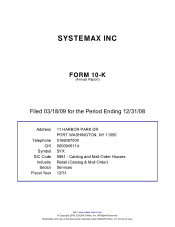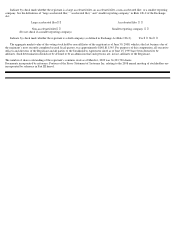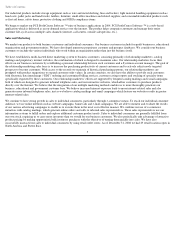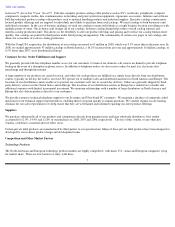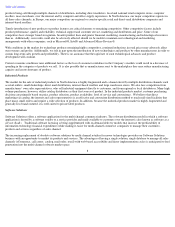Circuit City 2008 Annual Report Download - page 10
Download and view the complete annual report
Please find page 10 of the 2008 Circuit City annual report below. You can navigate through the pages in the report by either clicking on the pages listed below, or by using the keyword search tool below to find specific information within the annual report.
Table of Contents
products being sold through multiple channels of distribution, including direct marketers, local and national retail computer stores, computer
resellers, mass merchants, over the internet and by computer and office supply superstores. In North America, our major competitors operate in
all these sales channels; in Europe, our major competitors are regional or country-specific retail and direct-mail distribution companies and
internet-based resellers.
Timely introduction of new products or product features are critical elements to remaining competitive. Other competitive factors include
product performance, quality and reliability, technical support and customer service, marketing and distribution and price. Some of our
competitors have stronger brand-recognition, broader product lines and greater financial, marketing, manufacturing and technological resources
than us. Additionally, our results could also be adversely affected should we be unable to maintain our technological and marketing
arrangements with other companies, such as Microsoft®, Intel® and Advanced Micro Devices®.
With conditions in the market for technology products remaining highly competitive, continued reductions in retail prices may adversely affect
our revenues and profits. Additionally, we rely in part upon the introduction of new technologies and products by other manufacturers in order to
sustain long-term sales growth and profitability. There is no assurance that the rapid rate of such technological advances and product
development will continue.
Current economic conditions raise additional factors as the loss of consumer confidence in the Company’s markets could result in a decrease of
spending in the categories of products we sell. It is also possible that as manufacturers react to the marketplace they may reduce manufacturing
capacity and create shortages of product.
Industrial Products
The market for the sale of industrial products in North America is highly fragmented and is characterized by multiple distribution channels such
as retail outlets, small dealerships, direct mail distribution, internet-based resellers and large warehouse stores. We also face competition from
manufacturers’
own sales representatives, who sell industrial equipment directly to customers, and from regional or local distributors. Many high
volume purchasers, however, utilize catalog distributors as their first source of product. In the industrial products market, customer purchasing
decisions are primarily based on price, product selection, product availability, level of service and convenience. We believe that direct
marketing via catalog, the internet and sales representatives is an effective and convenient distribution method to reach mid-sized facilities that
place many small orders and require a wide selection of products. In addition, because the industrial products market is highly fragmented and
generally less brand oriented, it is well suited to private label products.
Software Solutions
Software Solutions offers a software application for the multi-channel commerce industry. The software distribution model in which a software
application is hosted by a software vendor or a service provider and made available to customers over the internet is also known as software as a
service (SaaS). Traditional software licensing is being supplemented with on-demand delivery models that increase the predictability of
information technology financial expenditures while making it easier for multi-channel commerce companies to manage their customers,
products and services regardless of sales channel.
The increasing replacement of obsolete software solutions by multi-channel retailers for newer technologies provides our Software Solutions
business with an opportunity to market its products and services. The advantages of having a single solution, single database to manage all sales
channels (eCommerce, call center, catalog, mail order, retail) with web-
based accessibility and faster implementation cycles is anticipated to fuel
penetration into the multi-channel software market space.
8

